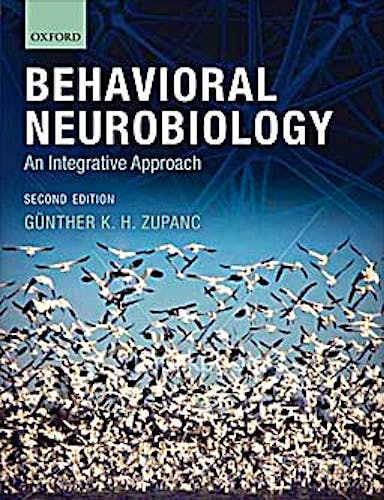

No hay productos en el carrito



Behavioral Neurobiology. an Integrative Approach
Zupanc, G.
2ª Edición Mayo 2010
Inglés
Tapa blanda
392 pags
1400 gr
19 x 25 x null cm
ISBN 9780199208302
Editorial OXFORD UNIVERSITY PRESS
LIBRO IMPRESO
-5%
38,37 €36,45 €IVA incluido
36,89 €35,05 €IVA no incluido
Recíbelo en un plazo de
2 - 3 semanas
ABOUT THIS BOOK
- An authoritative introduction to the fundamentals of behavioral neurobiology that examines not only the major findings in each area, but also experimental approaches used to obtain these results and the people behind them
- Summaries of key points, exercises, and further reading suggestions reinforce essential facts and themes and enable the reader to check and develop their understanding
- Comparative zoological approach emphasises common ideas to allows students to gain a thorough understanding of the principle concepts of behavioral neurobiology without overwhelming them with excessive detail
- Online Resource Centre features additional resources for students and lecturers to enhance the educational value of the text
New to this edition
- New Advanced Topic feature encourages students to engage with primary literature and develop critical thinking and reading skills
- New chapter on circadian rhythms looks at classical experiments and recent advances in the molecular structure and behavioral function of biological clocks
- Expanded coverage of myelin, electrical properties of neurons, chemical and electrical synapses, and ion channels
- A new major section in decision-making explores how neural circiuts control the generation of alternative types of behaviour
- Improved figures and new extensive glossary
Animals often exhibit intriguing and captivating patterns of behavior, from migration and homing, to communication. But how is this behavior controlled? Behavioral Neurobiology introduces undergraduate students and other readers to the fascinating field of neuroethology - the study of the neurobiological processes underlying animal behavior. Written in a lively, easy to read style, it examines the key concepts and ideas which underpin this intricate and elegant subject, and describes many of the groundbreaking discoveries that have helped us to unravel the mechanisms behind the behaviors we can observe.
Beginning with a look at the history of the study of behavior, from Aristotle to recent breakthroughs and predictions for the future, the book then reviews the ethological and neurobiological concepts that constitute the essential tools of behavioral neurobiology, before moving on to the field of neuroethology itself. In each chapter, the text not only describes the major findings in each area, but also the methods used to obtain these results.
· A wide range of examples and detailed case studies illustrate key ideas and concepts
· The subject is brought to life with the inclusion of boxes throughout the text containing biographical sketches of eminent past and present researchers
· Assumes no background knowledge of animal behavior or neurobiology
Online Resource Centre
The Online Resource Centre to accompany Behavioral Neurobiology features:
For students:
· 'In the News' periodic updates of relevant news items
· Hyperlinked bibliography
· Useful weblinks
For lecturers:
· Model answers to end of chapter questions
· Figures from the book, ready to download
Readership: Undergraduate and postgraduate students taking courses in behavioural neurobiology, neuroethology or similar.
AUTHOR INFORMATION
Günther K. H. Zupanc, Professor and Chair, Department of Biology of Northeastern
University in Boston, Massachusetts
REVIEWS
"Zupancs integrative approach towards the neural basis of behavior is
not only engagingly written and thus suitably fascinating to an interdisciplinary
readership, but also represents a well-structured text particularly appropriate
for teaching courses at the undergraduate and/or graduate level. In the context
of learning-tools, many novel features supplementing each chapter are appealing,
such as sectional outlines, marginal notes highlighting important points, key
concepts tackled in text boxes, summaries, a list of questions, and key references.
Biographical inserts of leading scientists contribute to the liveliness of the
treatment of the corresponding scientific case studies. " - Prof. em. Dr.
Jörg-Peter Ewert
TABLE OF CONTENTS
1: Introduction
2: Fundamentals of Neurobiology
3: Fundamentals of Ethology
4: The Study of Animal behavior: A brief history
5: Spatial Orientation and Sensory Guidance
6: Neuronal Control of Motor Output
7: Neuronal Processing of Sensory Information
8: Sensorimotor Integration: The Jamming Avoidance Response of the Weakly Electric
Fish Eigenmannia
9: Neuromodulation: The Accommodation of Motivational Changes in Behavior
10: Circadian Rhythms and Biological Clocks
11: Large-Scale Navigation: Migration and Homing
12: Communication: the Neuroethology of Cricket Song
13: Cellular Mechanisms of Learning and Memory
© 2026 Axón Librería S.L.
2.149.0